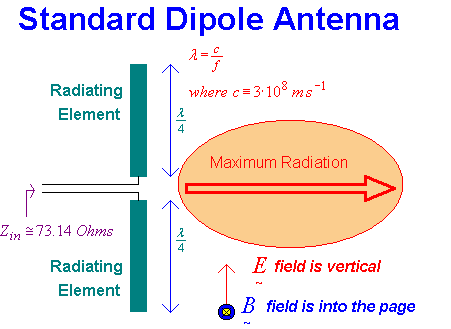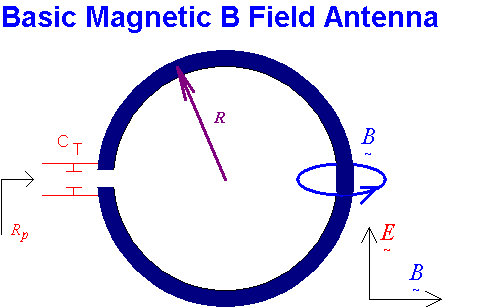Return To Kaleidoscope Comms
Or jump to following chapters
 The simplest "Dipole"
antenna consists of two metal rods arranged in a line with a balanced electrical
center feed. As with all antennae, "reciprocity" applies, so that
electrical to electromagnetic conversion efficiency is exactly the same as the
other way around. Unless energy is lost as heat somewhere in the system, the
efficiency of this conversion is 100 %. For the purpose of this article, I will
therefore only consider the transmission case where electrical energy is
converted to electromagnetic energy.
The simplest "Dipole"
antenna consists of two metal rods arranged in a line with a balanced electrical
center feed. As with all antennae, "reciprocity" applies, so that
electrical to electromagnetic conversion efficiency is exactly the same as the
other way around. Unless energy is lost as heat somewhere in the system, the
efficiency of this conversion is 100 %. For the purpose of this article, I will
therefore only consider the transmission case where electrical energy is
converted to electromagnetic energy.

Electrical energy supplied to the two radiating elements is converted to electromagnetic radiation. This consists of a vertical electrostatic component for the diagram shown, and an orthogonal magnetic component which in this example is perpendicular to the page.
The electrical feed impedance has been found to be approximately 73.14 Ohms when the total radiating element length is a ½ wavelength corresponding to the electrical input frequency f as shown in the diagram. The radiation pattern is mildly directional with a maximum output perpendicular to the elements forming a "torus" circling the elements.
The Dipole antenna can be physically long, especially at lower frequencies. For example, a standard Dipole antenna will be 1.5 meters long at f = 100 MHz based on the formula shown in the diagram. For portable applications this can be problematic. It is possible to use shorter radiating elements, but this causes the input resistance to fall and to develop a series negative reactive impedance (capacitive). For these electrically short Dipole antennae, the series resistive component follows the following relationship
 .. where L
represents the actual
length and L0
is the optimum length corresponding to ½ wavelength total Dipole
element length. Also, very approximately, the reactive component can be
estimated based on typical wire capacitance which tends to be about 20 pF per
meter length. Presumable each radiating element is in series for this very
approximate estimate.
.. where L
represents the actual
length and L0
is the optimum length corresponding to ½ wavelength total Dipole
element length. Also, very approximately, the reactive component can be
estimated based on typical wire capacitance which tends to be about 20 pF per
meter length. Presumable each radiating element is in series for this very
approximate estimate.
The difficulty here is not one of diminished radiation, as energy in has to equal energy out of course, unless the radiating elements are lossy and convert some of the electrical input energy to heat. As such, even short Dipole antennae can have the same theoretical electrical to electromagnetic efficiency of 100 %. Practical difficulties exist at the electrical feed point however. Electrical losses associated with large impedance transformations, and then the need to cancel the reactive component with an inductive counter-measure increase severely for shortened element lengths. For example, the resistive component falls to a few Ohms when the actual length is ¼ the optimum half wavelength.
A variation of the standard Dipole is the Helix Dipole. In this variant, the elements are replaced with spiral coils. This arrangement improves the impedance characteristics for electrically shortened antennae, and is popular for walky-talkies in a shortened ¼ wavelength single element radiator. In this case, the body (and user's hand) of the walky-talky forms the missing other element.
These helical antennae, sometimes referred to as "rubber-duckys" shorten the antenna length by a factor of 2 or more, but are unsuitable for very small size applications such as Paging receivers etc. In addition, they are extremely sensitive to surrounding conductive elements as they have relatively high end impedance, and any additional capacitive contribution detunes them, causing power loss.
For example, even the conductive property of (saline) blood is adequate to detune a Dipole antenna. Such antennae could not be used in a receiver required to be worn on a person's body, for example. The every changing capacitive, and resistively lossy loading would impair the Dipole antenna's radiation efficiency considerably. To solve these difficulties, an alternative radiating mechanism is needed. This is where the Magnetic B Field Antenna comes to the rescue, often referred to as a "loop antenna".
This antenna consists of one or more wire loops forming an inductor with the opportunity to radiate energy in the form of an electromagnetic field. Being inductive, a capacitor is needed to tune this reactive component out.

This antenna configuration is very useful for very small size applications relative to a wavelength. Medium wave broadcast radios designed for AM reception often use these loop antennae, and often assist the magnetic performance by adding a high permeability ferrite rod through the center. For practical purposes, the inductance is increased to usable values by increasing the number of turns to 50 or so.
The single loop Magnetic B field antenna is most suitable for frequencies from 50 MHz to 1000 MHz, and can be quite effective. The primary radiation is magnetic, but some residual electrostatic field results. As distance from the B field antenna increases, this ratio normalizes to that expected in electromagnetic waves. This can be referred to as the "far field" as opposed to the "near field" where the radiation simply represents normal inductive energy transfer (as in a transformer).
Magnetic B field antennae are also useful for direction finding as they exhibit directional behavior, especially as reception nulls when the source is perpendicular to the loop. In order to improve the depth of this null, the loop is placed inside a conductive metal tube. This prevents unwanted electrostatic pickup, which may be somewhat unidirectional. In order to prevent the magnetic field from being "shorted out" the tube has a gap preventing a complete closed circuit. The inner loop connections can be bought out through this gap.

The electrostatic shielded B field antenna attempts to reduce parasitic electrostatic radiation (and therefore reception) to zero, leaving only the magnetic component, at least in the near field zone. This property also allows the shielded magnetic B field antenna to be placed close to metal objects with relatively little impairment. Circular arrangements can be replaced by square approaches that allow the use of straight metal tubing with 90 degree elbow bends. The use of coax cable has also been explored. Neither are suitable for miniature products however. Still, a planar approach based on multiple layer certainly is. This implementation will be discussed in following chapters, along with some of the theory behind the basic operation.
Or return To Kaleidoscope Comms